 English
English



-
 Afrikaans
Afrikaans -
 Albanian
Albanian -
 Amharic
Amharic -
 Arabic
Arabic -
 Armenian
Armenian -
 Azerbaijani
Azerbaijani -
 Basque
Basque -
 Belarusian
Belarusian -
 Bengali
Bengali -
 Bosnian
Bosnian -
 Bulgarian
Bulgarian -
 Catalan
Catalan -
 Cebuano
Cebuano -
 China
China -
 China (Taiwan)
China (Taiwan) -
 Corsican
Corsican -
 Croatian
Croatian -
 Czech
Czech -
 Danish
Danish -
 Dutch
Dutch -
 English
English -
 Esperanto
Esperanto -
 Estonian
Estonian -
 Finnish
Finnish -
 French
French -
 Frisian
Frisian -
 Galician
Galician -
 Georgian
Georgian -
 German
German -
 Greek
Greek -
 Gujarati
Gujarati -
 Haitian Creole
Haitian Creole -
 hausa
hausa -
 hawaiian
hawaiian -
 Hebrew
Hebrew -
 Hindi
Hindi -
 Miao
Miao -
 Hungarian
Hungarian -
 Icelandic
Icelandic -
 igbo
igbo -
 Indonesian
Indonesian -
 irish
irish -
 Italian
Italian -
 Japanese
Japanese -
 Javanese
Javanese -
 Kannada
Kannada -
 kazakh
kazakh -
 Khmer
Khmer -
 Rwandese
Rwandese -
 Korean
Korean -
 Kurdish
Kurdish -
 Kyrgyz
Kyrgyz -
 Lao
Lao -
 Latin
Latin -
 Latvian
Latvian -
 Lithuanian
Lithuanian -
 Luxembourgish
Luxembourgish -
 Macedonian
Macedonian -
 Malgashi
Malgashi -
 Malay
Malay -
 Malayalam
Malayalam -
 Maltese
Maltese -
 Maori
Maori -
 Marathi
Marathi -
 Mongolian
Mongolian -
 Myanmar
Myanmar -
 Nepali
Nepali -
 Norwegian
Norwegian -
 Norwegian
Norwegian -
 Occitan
Occitan -
 Pashto
Pashto -
 Persian
Persian -
 Polish
Polish -
 Portuguese
Portuguese -
 Punjabi
Punjabi -
 Romanian
Romanian -
 Russian
Russian -
 Samoan
Samoan -
 Scottish Gaelic
Scottish Gaelic -
 Serbian
Serbian -
 Sesotho
Sesotho -
 Shona
Shona -
 Sindhi
Sindhi -
 Sinhala
Sinhala -
 Slovak
Slovak -
 Slovenian
Slovenian -
 Somali
Somali -
 Spanish
Spanish -
 Sundanese
Sundanese -
 Swahili
Swahili -
 Swedish
Swedish -
 Tagalog
Tagalog -
 Tajik
Tajik -
 Tamil
Tamil -
 Tatar
Tatar -
 Telugu
Telugu -
 Thai
Thai -
 Turkish
Turkish -
 Turkmen
Turkmen -
 Ukrainian
Ukrainian -
 Urdu
Urdu -
 Uighur
Uighur -
 Uzbek
Uzbek -
 Vietnamese
Vietnamese -
 Welsh
Welsh -
 Bantu
Bantu -
 Yiddish
Yiddish -
 Yoruba
Yoruba -
 Zulu
Zulu
zero sequence impedance test of transformer
Understanding Zero Sequence Impedance Testing of Transformers
Transformers are pivotal components in electrical systems, utilized for voltage transformation and power distribution. Their efficiency and reliability are critical to the overall performance of electrical networks. One important aspect of transformer maintenance and testing is the assessment of zero sequence impedance, which provides valuable insights into the transformer's condition and performance.
What is Zero Sequence Impedance?
Zero sequence impedance is a parameter that measures how a transformer responds to zero sequence currents—currents that are equal in magnitude and phase in all three phases of a three-phase system. These currents often occur during unbalanced load conditions or fault situations, such as line-to-ground faults. Understanding how a transformer interacts with these currents is essential for ensuring its reliability and stability in power systems.
The zero sequence impedance can be represented as a complex number, reflecting both its resistive and reactive components. It is expressed as Z0 = R0 + jX0, where R0 is the resistance and X0 is the reactance. The magnitude of this impedance can impact the phase relationship and magnitude of the current flowing through the transformer during fault conditions.
Importance of Zero Sequence Impedance Testing
Testing zero sequence impedance plays a critical role in transformer analysis for several reasons
1. Fault Detection By evaluating the zero sequence impedance, technicians can identify potential issues within the transformer, which could lead to failings under fault conditions. 2. System Stability A transformer that interacts poorly with zero sequence currents can compromise the stability of the entire electrical system during unbalanced conditions. Accurate measurement of zero sequence impedance helps mitigate this risk.
zero sequence impedance test of transformer

4. Condition Monitoring Regular testing of zero sequence impedance can serve as a valuable tool for condition monitoring and life assessment of transformers, enabling proactive maintenance strategies.
Methodology for Testing Zero Sequence Impedance
To perform a zero sequence impedance test on a transformer, specialized equipment is used, typically involving insulation resistance testers or impedance analyzers. The test procedure generally involves
1. Connection Setup The transformer secondary windings are connected in such a way as to facilitate the injection of zero sequence current.
2. Current Injection A known current is injected into the transformer, while the corresponding voltage drop across the transformer windings is measured.
3. Impedance Calculation The zero sequence impedance is calculated using Ohm's law (Z0 = V0 / I0), whereby the measured voltage (V0) and injected current (I0) are used to determine the impedance.
4. Analysis of Results The obtained impedance values are compared with industry standards or manufacturer specifications to evaluate the transformer's condition.
Conclusion
Zero sequence impedance testing is a significant aspect of transformer diagnostics. It gives engineers and maintenance personnel a clearer picture of how the transformer behaves under adverse conditions and helps in planning preventive measures to avoid failures. Regular testing, combined with other diagnostic techniques, allows for a comprehensive understanding of transformer health, ultimately enhancing the reliability and efficiency of electrical power systems. As power systems evolve and demand for reliable energy increases, the role of such testing practices will only become more paramount in ensuring the safe and efficient operation of transformers.
-
Exploring the Main Types of Industrial Endoscopes and Their Applications Across IndustriesNewsJul.04,2025
-
Testing Equipment Industry Sees Major Advancements in 2025: Smart & Precision Technologies Lead the WayNewsJun.06,2025
-
Applications of Direct Current Generators in Renewable Energy SystemsNewsJun.05,2025
-
Hipot Tester Calibration and Accuracy GuidelinesNewsJun.05,2025
-
Digital Circuit Breaker Analyzer Features and BenefitsNewsJun.05,2025
-
Benefits of Real-Time Power Quality Monitoring Devices for Industrial EfficiencyNewsJun.05,2025



